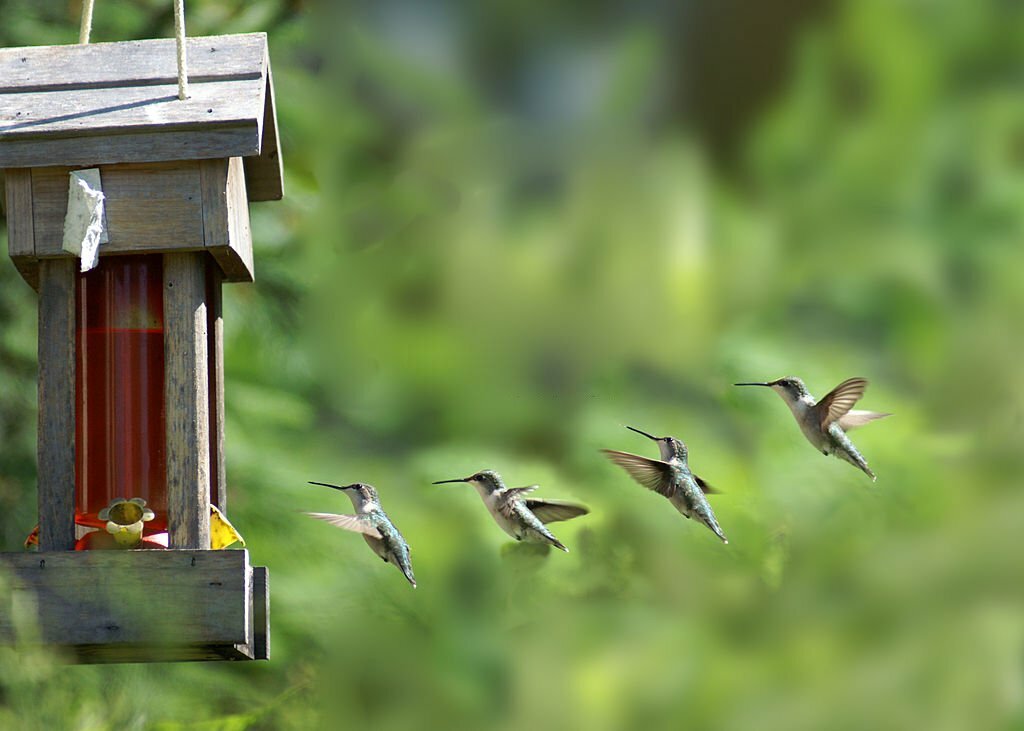
Hummingbirds, those tiny, colorful birds that flit around your garden, don't just go by their individual names. When they come together, they form something special, and we're about to uncover that secret in the world of birds.
A group of hummingbirds is usually called a "charm," this name suits them well because they are quite small.
There are a couple of other names you might hear for a bunch of hummingbirds, like a "shimmer" or a "bouquet." Hummingbirds belong to the Trochilidae family, which includes a whopping 366 different species, and they are found exclusively in the Americas. These birds are famous for their incredible flying skills and vibrant, colorful feathers.
Hummingbird Charms: Family And Friends
The hummingbird, with its tiny size and vibrant colors, is a creature that captivates the human imagination effortlessly. Its graceful flight and rapid wingbeats evoke a sense of wonder, making it a captivating symbol of the beauty and fragility of life.
Out of the 366 species of hummingbirds, most don't usually hang out together for long when they're feeding. Hummingbirds are quite independent and don't like having other hummingbirds around while they get their food. Even though they chase away their rivals, a few hummingbirds can still grab a bite from the same spot.
These birds are loners, even when it's time to find a mate. For example, during their short courtship period, which lasts just a few minutes, the ruby-throated and calliope hummingbirds don't spend much time together.
Why Are Hummingbirds Solitary?
Many bird species, like snipes, flycatchers, warblers, and robins, prefer to live independently. This solitary behavior has advantages because each bird can decide when to find food and places to breed without being part of a group.
In the case of hummingbirds, one of the main reasons they adopted this solitary lifestyle is likely to increase their chances of successful breeding.
Since male hummingbirds can mate with several females during the breeding season, being alone helps them maximize their chances of finding mates.
Considering these little birds have a very short lifespan, having smaller clutch sizes of eggs probably works in their favor.
Charms During Migration
It's quite surprising that some hummingbird species are highly migratory, considering their small size and tiny wings. Take, for example, the calliope hummingbird, which travels from as far north as Canada to as far south as Mexico and Central America during the winter. These little birds are only about three inches long and are the tiniest and lightest mammals to undertake such a long journey.
Another traveler is the black-chinned hummingbird, which embarks on a lengthy journey from its nesting sites to wintering spots in Central America. The rufous hummingbird takes a similar 2,000-mile trip across the Rocky Mountains, starting from its breeding sites in Alaska.
What's really fascinating is that hummingbirds make these long journeys all on their own. They have an inborn ability for migration and don't appear to learn their routes by watching other hummingbirds, which surprises scientists. However, sometimes, they do travel alongside larger birds during their migrations.
How Many Hummingbirds Live In The Average Charm?
Sometimes, you might spot hummingbirds gathering around bird feeders in gardens or lush tropical rainforest areas where food is abundant. There's even a video from Ecuador that shows a significant group of hummingbirds all dining together.
It's quite a lucky sight to see multiple hummingbirds peacefully sharing a meal without one chasing the others away. However, some folks have attracted several hummingbirds to their gardens, often from different species, creating a delightful mix of these tiny, colorful birds.
What Do You Call A Pair Of Hummingbirds?
A pair of hummingbirds don't have a special name. Hummingbirds tend to be polygamous, which means the male usually spends only the necessary amount of time with the female, who takes on all the responsibilities for the nest and its upkeep.
Both males and females live solitary lives and can be quite territorial, often showing aggression toward each other and even other small creatures or insects that enter their space.
It's worth noting that because hummingbirds are small, secretive birds that live deep within dense habitats, their behavior needs to be better understood for many species. Therefore, it's highly unlikely that any hummingbird species is slightly monogamous.
Fun Facts About Hummingbirds
- They are the tiniest birds that travel long distances. Unlike other birds that fly in groups, they fly alone for up to 500 miles.
- The name "hummingbird" comes from the sound their wings make when they flap really fast.
- Hummingbirds can't smell things, but they can see colors really well. Some, like the Ruby-throated Hummingbird, like orange or red flowers. However, don't use red dye in their nectar because it can harm them. Instead, plant red or orange flowers or use feeders with red parts.
- A hummingbird weighs less than a nickel.
- Their tiny legs are only for perching and moving sideways while perched. They can't walk or hop.
- Hummingbirds drink nectar from feeders by sticking their tongues in and out super fast, about 13 times per second. They can drink up to twice their body weight in a day.
- Female hummingbirds usually lay only two eggs. These eggs are found in nests smaller than a half dollar and are about the size of a jellybean or a coffee bean. Some kinds, like the Black-chinned Hummingbird, use plant fluff, spider silk, and other natural things to build nests that can get bigger as their babies grow.
- A group of hummingbirds can be called a bunch, a sparkly group, a hovering gang, a shiny crowd, or a musical gathering.